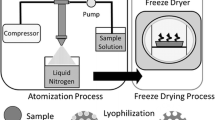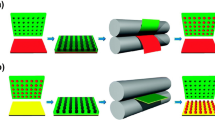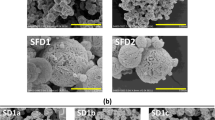Abstract
Purpose. To develop a new technique, spray freeze drying, for preparing protein aerosol powders. Also, to compare the spray freeze-dried powders with spray-dried powders in terms of physical properties and aerosol performance.
Methods. Protein powders were characterized using particle size analysis, thermogravimetric analysis, scanning electron microscopy, X-ray powder diffractometry, and specific surface area measurement. Aerosol performance of the powders was evaluated after blending with lactose carriers using a multi-stage liquid impinger or an Anderson cascade impactor. Two recombinant therapeutic proteins currently used for treating respiratory tract-related diseases, deoxyribonuclase (rhDNase) and anti-IgE monoclonal antibody (anti-IgE MAb), were employed and formulated with different carbohydrate excipients.
Results. Through the same atomization but the different drying process, spray drying (SD) produced small (∼3 μm), dense particles, but SFD resulted in large (∼8−10 μm), porous particles. The fine particle fraction (FPF) of the spray freeze-dried powder was significantly better than that of the spray-dried powder, attributed to better aerodynamic properties. Powders collected from different stages of the cascade impactor were characterized, which confirmed the concept of aerodynamic particle size. Protein formulation played a major role in affecting the powder's aerosol performance, especially for the carbohydrate excipient of a high crystallization tendency.
Conclusions. Spray freeze drying, as opposed to spray drying, produced protein particles with light and porous characteristics, which offered powders with superior aerosol performance due to favorable aerodynamic properties.
Similar content being viewed by others
REFERENCES
E. G. Rippie. Powders. In: E. W. Martin (ed), Remington's Pharmaceutical Sciences, 17th ed., pp. 1585–1602 (1985).
S.-D. Yeo, G.-B. Lim, P. G. Debenedetti, and H. Bernstein. Formation of microparticulate protein powders using a supercritical fluid antisolvent. Biotechn. Bioeng. 41:341–346 (1993).
M. A. Winters, B. L. Knutson, P. G. Debenedetti, H. G. Sparks, T. M. Przybycien, C. L. Stevenson, and S. J. Prestrelski. Precipitation of proteins in supercritical carbon dioxide. J. Pharm. Sci. 85:586–594 (1996).
W. R. Gombotz and L. R. Brown. Process for producing small particles of biologically active molecules,” International Patent Application PCT/US90/02421 (1990).
A. J. Hickey, N. M. Concessio, M. M. Van Oot, and R. M. Platz, Factors influencing the dispersion of dry powders as aerosols. Pharm. Tech. 18:58–82 (1994).
Y.-F. Maa, H. R. Costantino, P.-A. Nguyen, and C. C. Hsu. The effect of operating and formulation variables on the morphology of spray-dried protein particles. Pharm. Dev. Tech. 2:213–223 (1997).
D. A. Edwards, J. Hanes, G. Caponetti, J. Hrkach, A. Ben-Jebria, M. L. Eskew, J. Mintzes, D. Deaver, N. Lotan, and R. Langer. Large porous particles for pulmonary drug delivery. Science 276:1868–1871 (1997).
Y.-F. Maa, P.-A. Nguyen, K. Sit, and C. C. Hsu. Spray-drying performance of bench-top spray dryer for protein aerosol powder preparation. Biotechn. Bioeng. in press.
Y. F. Maa, P. A. Nguyen, J. D. Andya, N. Dasovich, T. D. Sweeney, S. J. Shire, and C. C. Hsu. Effect of spray drying and subsequent processing conditions on residual moisture content and physical/biochemical stability of protein inhalation powders. Pharm. Res. 15:768–775 (1998).
Y. F. Maa, P. A. Nguyen, and C. Hsu. Spray drying of air-liquid interface sensitive recombinant human growth hormone. J. Pharm. Sci. 87:152–159 (1998).
Author information
Authors and Affiliations
Corresponding author
Rights and permissions
About this article
Cite this article
Maa, YF., Nguyen, PA., Sweeney, T. et al. Protein Inhalation Powders: Spray Drying vs Spray Freeze Drying. Pharm Res 16, 249–254 (1999). https://doi.org/10.1023/A:1018828425184
Issue Date:
DOI: https://doi.org/10.1023/A:1018828425184




